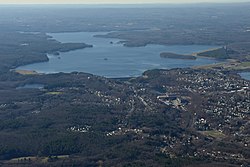Wachusett Reservoir
| Wachusett Reservoir | |
|---|---|

Wachusett Reservoir and Dam from above Clinton, Massachusetts
|
|
| Location | Worcester County, Massachusetts, United States |
| Coordinates | 42°22′10″N 71°44′18″W / 42.36944°N 71.73833°WCoordinates: 42°22′10″N 71°44′18″W / 42.36944°N 71.73833°W |
| Type | Reservoir |
| Primary inflows | Nashua River, Quinapoxet River, Stillwater River, Quabbin Aqueduct |
| Primary outflows | Wachusett Aqueduct, Cosgrove Tunnel, Nashua River |
| Catchment area | 108 sq mi (280 km2) |
| Basin countries | United States |
| Max. length | 7 mi (11 km) |
| Max. width | 1.1 mi (1.8 km) |
| Surface area | 7 sq mi (18 km2) |
| Average depth | 48 ft (15 m) |
| Max. depth | 120 ft (37 m) |
| Water volume | 65,000,000,000 US gal (0.25 km3) |
| Shore length1 | 21 mi (34 km) |
| Surface elevation | 384 ft (117 m) |
| Settlements | Clinton, Lancaster, West Boylston, Boylston, Sterling |
| 1 Shore length is not a well-defined measure. | |
The Wachusett Reservoir is the second largest body of water in the state of Massachusetts. It is located in central Massachusetts, northeast of Worcester. It is part of the water supply system for metropolitan Boston maintained by the Massachusetts Water Resources Authority (MWRA). It has an aggregate capacity of 65 billion US gallons (250,000,000 m3) and an area of almost 7 square miles (18.2 km²). Water from the Wachusett flows to the covered Norumbega Storage Facility via the Cosgrove Tunnel and the MetroWest Water Supply Tunnel. The reservoir has a maximum depth of 120 feet (36.5 m) and a mean depth of 48 feet (14.6 m).
The reservoir serves as both an intermediate storage reservoir for water from the Quabbin Reservoir as well as a water source itself as it is also fed by its own watershed. The reservoir is fed by the Quinapoxet, and Stillwater rivers, along with the Quabbin Aqueduct, which carries water from the Quabbin Reservoir. It is part of the Nashua River Watershed and is the headwaters of the Nashua River. Because it is an intermediate storage reservoir, its water levels are kept relatively constant while the Quabbin Reservoir fluctuates based on precipitation and demand. At times when the Wachusett Reservoir becomes high due to its own watershed producing a large amount of runoff such as during snow melting, the flow from the Quabbin is shut off and water from the Ware River flows backwards down the Quabbin Aqueduct into the Quabbin Reservoir for storage.
In 1897, the Nashua River above the town of Clinton was impounded by the Wachusett Dam. 4,380 acres (17.5 km²) were flooded in the towns of Boylston, West Boylston, Clinton, and Sterling. Work was completed in 1905 and the reservoir first filled in May 1908. Its water was originally delivered to the Sudbury Reservoir via the Wachusett Aqueduct, with the Cosgrove Tunnel (completed in 1965) providing redundancy. Interconnections at the Sudbury Reservoir eventually delivered the water to the Weston Reservoir via the Weston Aqueduct; these downstream facilities were relegated to backup roles in the late 20th and early 21st century by the construction of the MetroWest Water Supply Tunnel and covered storage facilities.
...
Wikipedia
